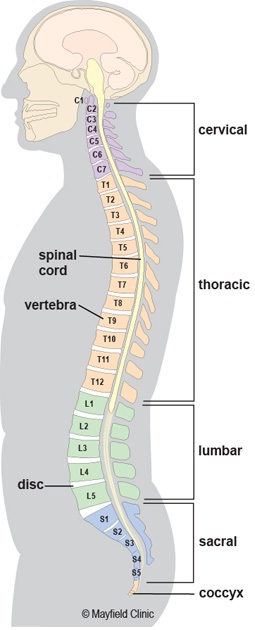by Alan Jordan
The lower back region is called the Lumbar Spine. It begins just below the area of the ribs and connects the mid back (Thoracic Spine) to the pelvic area (Sacral Spine). The Lumbar Spine has 5 vertebrae, a disc in between each vertebral body, and bony projections towards the rear, which serve as attachment points for the muscles of the back. It is indeed an impressive structure and is built for power as well as flexibility.
As the reader will readily see, the front of the spine – comprising the discs and the vertebral bodies – is designed to carry. Ultimately they carry the entire upper body, which comprises 70% of the body’s weight! The rear of the spine, which has the muscular attachments as well as the joints that connect each vertebral pair, maintain the erect posture and allow for movement. The Lumbar Spine has a forwardly slopped curve, which enables it to disperse weight.
The lumbar spine differs from other regions of the spine in that:
- The five vertebrae of the lumbar spine (L1-L5) are the biggest unfused vertebrae in the spine, enabling them to support the weight of the entire torso.
- The lumbar spine’s lowest two spinal segments, L4- L5 and L5-S1, which include the vertebrae and discs, bear the most weight and are therefore the most prone to degeneration and injury.
- The lumbar spine meets the Sacral Spine at the lumbosacral joint (L5-S1). This joint allows for considerable rotation, so that the pelvis and hips may swing when walking and running.
In addition to maintaining upright posture, carrying the upper body and allowing for considerable movement, the Lumbar Spine must protect the vital spinal cord (see illustration above). The spinal cord is a continuation of the brain and sends out messages as well as receiving them from the entire body. These nerves that control the function of the legs exit the Lumbar Spine between each set of vertebrae.
Injuries and evidence-based treatments to the different structures that make up the Lumbar Spine will be dealt with in the articles that follow.
Alan Jordan is a clinic director at Broadgate Spine & Joint Clinic. For more information about his history and work, go to https://www.broadgatespinecentre.co.uk/chiropractor-london/.





